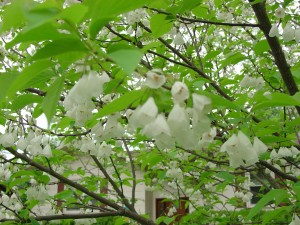Carolina silverbells (Halesia spp.) bloom as the last bracts of flowering dogwood (Cornus florida) have fallen. Clusters of white or pale pink bell-shaped flowers open along the branches. Flowers appear first and medium green leaves emerge a few days later. Silverbells vary tremendously in the wild. Some grow large shrub-like, or as small multi-trunked trees to 20-25 feet in height, or as medium 30 to 50 feet high and 20 to 35 feet wide.
Over the past decade botanists have reclassified Halesia. Two-winged silverbell (H. diptera) grows a small 20-30 feet tall and wide, and fruits are 2-winged drupe seed capsules. Carolina silverbell (H. tetraptera, formerly H. carolina) is the taller species at 30-40 feet high and 25-30 feet wide, and fruits are 4-winged drupe seed capsules.
Young multi-stemmed shrubs are easily trained into single trunk trees. Fall leaf color is variable, in most years turning pale yellow in the Southern Appalachian region (USDA hardiness zones 6 and 7). Dry brownish seed capsules persist through most of the winter. In the winter months the dark gray-furrowed bark, marked with thin black vertical lines, is more noticeable.
Silverbell is primarily an understory tree, preferring partial sun (full morning sun, afternoon shade). Ideally, it prefers a slightly acidic, compost- rich, moist, well-drained soil. summer foliage often yellows (turns chlorotic) in high pH soils. Irrigate a newly planted tree in years 1 and 2 until it adapts to moderately dry summers. Fertilize lightly in late winter or before the tree blooms.
Leading cultivars: H. tetraptera ‘Rosea’ opens rose-pink and fade to pale pink. H. diptera ‘Magniflora’ bears 25% larger blooms than the species. ‘Wedding Bells’ is a new multi-branched shrub form from Dr. Mark Brand at the University of Connecticut.
Silverbells are disease and pest free if properly sited. This wonderful native provides food and shelter for birds and pollinating insects.


 Posted in
Posted in 
